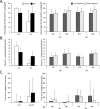Effects of low back pain stabilization or movement system impairment treatments on voluntary postural adjustments: a randomized controlled trial
- PMID: 25452017
- PMCID: PMC4375040
- DOI: 10.1016/j.spinee.2014.10.020
Effects of low back pain stabilization or movement system impairment treatments on voluntary postural adjustments: a randomized controlled trial
Abstract
Background: People with low back pain (LBP) exhibit impaired anticipatory postural adjustments (APAs).
Objective: To evaluate whether current motor retraining treatments address LBP-associated changes in movement coordination during tasks that do and do not require APAs.
Design: Prospectively registered randomized controlled trial with a blinded assessor.
Setting: Outcome evaluations occurred in a university laboratory; treatments were carried out in outpatient physical therapy clinics.
Patients: Fifteen subjects without LBP and 33 subjects with chronic, recurrent, and nonspecific LBP.
Intervention: Twelve subjects with LBP received stabilization treatment, 21 received movement system impairment-based treatment, for more than 6 weekly 1-hour sessions plus home exercises.
Measurements: Pre- and post-treatment, surface electromyography (EMG) was recorded bilaterally from trunk and leg muscles during unsupported and supported leg-lifting tasks, which did and did not require an APA, respectively. Vertical reaction forces under the contralateral leg were recorded to characterize the APA. Oswestry disability scores and numeric pain ratings were also recorded.
Results: Persons with LBP demonstrated an impaired APA compared with persons without LBP, characterized by increased premovement contralateral force application and increased postmovement trunk EMG amplitude, regardless of the task. After treatments, both groups similarly improved in disability and function; however, APA characteristics did not change (ie, force application or EMG amplitude) in either task.
Limitations: Treating clinicians were not blinded to treatment allocation, only short-term outcomes were assessed, and main effects of treatment do not rule out nonspecific effects of time or repeated exposure.
Conclusions: Movement impairments in persons with LBP are not limited to tasks requiring an APA. Stabilization and movement system impairment-based treatments for LBP do not ameliorate and may exacerbate APA impairments (ie, excessive force application and increased post-movement trunk muscle activation).
Keywords: Aberrant movement patterns; Anticipatory postural adjustment (APA); Force application.; Low back pain (LBP); Movement systems impairment (MSI) approach; Stabilization approach.
Copyright © 2015 Elsevier Inc. All rights reserved.
Figures




References
-
- Andersson GB, Frymoyer JW. The Epidemiology of Spinal Disorders. Lippincott-Raven Publishers; Philadelphia, PA: 1997.
-
- Katz JN. Lumbar disc disorders and low-back pain: socioeconomic factors and consequences. J Bone Joint Surg Am. 2006;88:21–24. - PubMed
-
- Martin BI, Deyo RA, Mirza SK, et al. Expenditures and Health Status Among Adults With Back and Neck Problems. The Journal of the American Medical Association. 2008;299(6):656–664. - PubMed
-
- Carpenter MG, Frank JS, Adkin AL, Paton A, Allum JH. Influence of postural anxiety on postural reactions to multi-directional surface rotations. J Neurophysiol. 2004;92(6):3255–3265. - PubMed
Publication types
MeSH terms
Grants and funding
LinkOut - more resources
Full Text Sources
Other Literature Sources
Medical
Miscellaneous

